|
 BIRTH OF THW DIGITAL ERA
BIRTH OF THW DIGITAL ERA
A major effort was made in the mid sixties to perfect water saturation
analysis in shaly sands. Archie's equation was not designed
for this situation. Many competing methods were proposed, but
the fallout left the Simandoux equation (about l965) with the
Waxman-Smits method (l968) holding sway for a zealous few. Most
of the methods, including Simandoux, suffer from lack of rigor
or have a physically unsatisfying model. The Waxman-Smits method
is theoretically acceptable but some of the data needed for the
equations (such as cation exchange capacity of the rock) cannot
be obtained from logs reliably. It is difficult and expensive
to get from measurements on cores of real rocks, especially if
there are no cores to be found from the zone in question.
Another
approach is called the dual-water model (or bulk volume water
method), published by various authors between l968 and l97l. It
segregates the total amount of water in a formation into two parts
- that bound to the shale (bound-water) and that in the pore space
(pore water). The method is currently popularized in most service
company programs, both in the office and on the computerized logging
trucks at the wellsite.
Controversy
still rages over the best water saturation method and the ultimate
water saturation equation has yet to be presented.
Water
saturation analysis in shaly sands and porosity determination
were both being studied in the late sixties. With several independent
sources of data, and with more unknowns than measurements, a new
style of analysis was proposed. Instead of solving a fixed
set of simultaneous equations, various iterative solutions were
used to minimize the change in one or several computed results.
The
primary goal was to correct for shale, light hydrocarbon effect,
heavy mineral effect, and to solve for porosity and lithology
at the same time. Success depended greatly on log data quality
and on how well the calculation model actually fit the real geology.
Much work is still being done in this area and new approaches
appear in journals yearly.
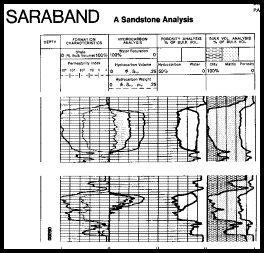 |
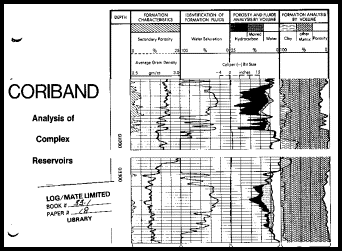 |
SARABAND Computed Log c.1971 CORIBAND Computed
Log c.1971 |
These
models absolutely depended on high powered computers, digital
data recording (first achieved in l965) and great patience, since
results did not appear quickly. Weeks or months might be needed
to get results for even a small group of related wells. This situation
has improved markedly since 1985.
More
advanced computer programs for carbonate rocks appeared in l97l
to provide a similar service as was available for the shaly sand
situation. The goal in this program was automatic hydrocarbon
correction and mineral identification.
The
best known examples of these programs are Schlumberger's SARABAND
(superceded by VOLAN and ELAN), CORIBAND, and Dresser Atlas' EPILOG
products. All these methods are iterative refinements of the crossplot
or simultaneous equation solutions.
During
the seventies and early eighties, these methods were programmed
on low cost sophisticated hand calculators. If large volumes of
data were required, desktop computers with digitizers, plotters
and printers could be obtained from several sources. Today, the
ubiquitous personal computer does the work at a fraction of the
cost and time.
The
first truly portable stand-alone desktop system that did not require
connection to a large mainframe computer was LOG/MATE, developed
by the author and D. W. Curwen in l976. This was 5 years before
IBM "invented" the PC. It has since been mimicked and
improved upon by many others, so that a wide range of such systems
are available.
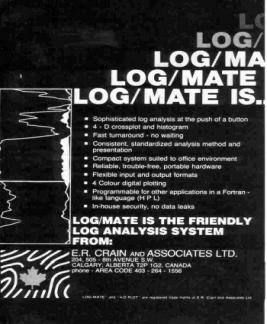
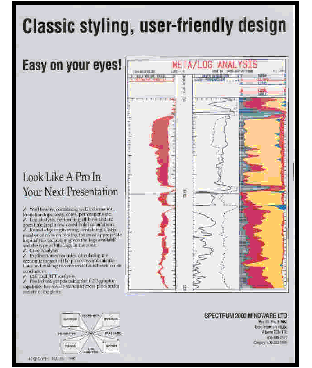
LOG/MATE, the first commercial desktop log analysis software
package (1976, left) and META/LOG, the first spreadsheet-based log
analysis package (1986, right), both developed by the author.
Timeshare
systems using computer terminals to larger mainframes or mini-computers
were first seen in l965, and are still used. Both batch and interactive
time share systems can be found in many oil companies, service
companies, and consulting firms. The phrase "time sharing"
has disappeared from computer lingo but the concept persists with
local area networks, UNIX servers, and distributed computing.
Log
analysis methods vary from crude to complex and the quality of
results varies with the knowledge and experience of the analyst.
The quality and age of input data is always a problem to consider.
Simpler systems, with a good analyst at the controls, often provide
better results, because of the personal input and knowledge of
the analyst. More complex programs tend to do unexpected things
and are not easy to control, even by expert log analysts.
Moving
the analysis from the office to the wellsite, to speed up decision
making, has always been a driving force in analysis techniques.
Of course, all the manual methods described above could be performed
at the wellsite, using charts and slide rules, and later with
electronic calculators.
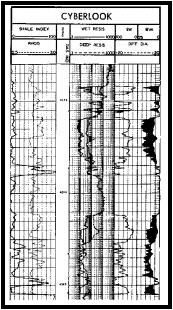 In
l963, attempts were made to interpret porosity and water saturation
automatically by recording the so-called moveable oil plot. This
involved analog processing of log curves to obtain the appropriate
data. How many readers actually know what an analog computer is? In
l963, attempts were made to interpret porosity and water saturation
automatically by recording the so-called moveable oil plot. This
involved analog processing of log curves to obtain the appropriate
data. How many readers actually know what an analog computer is?
CYBERLOOK Computed Log Analysis c. 1976
While digital recording of well logs began in l965, early trials
of digital computation at the wellsite did not begin until l972.
After this date, the major service companies have almost completely
replaced all their older analog logging units. This provided both
log analysis and calibration control by computer. The best
known analysis examples are Schlumberger's CYBERLOOK and
Dresser's PROLOG products.
A
number of new tools, revised uses of older tools, and significant
advances in computer processing of log data have been introduced
in the 1980's, and are gaining rapid acceptance by well operators.
Satellite
transmission of log data from the wellsite to service company
computer centers superceded the Telecopier and FAX machine in
many areas, allowing faster decision making at the head office,
somewhat to the detriment of local autonomy and egos.
The
lithodensity log is an improved density log with reduced statistical
variations on the density measurement, and a new curve - the photo
electric capture cross-section curve, better known as the PE curve.
Its' value depends on the rock lithology and is relatively unaffected
by porosity and pore fluid type. Therefore, it can be used to
assist in lithology identification in simultaneous equation solutions.
The
natural gamma ray spectrolog, mentioned earlier, is now also widely
used to resolve lithology problems, such as radioactive dolomite
or granite wash formations, or to help define clay types in shale.
It provides three primary curves - the potassium, thorium and
uranium curves, which when summed, give the total gamma ray curve.
These three curves, plus the three porosity curves (density, sonic
and neutron), and the Pe curve provide seven independent measurements
of formation properties, which should allow a total of eight lithologic
properties to be calculated from the data.
The
three usual resistivity curves, the caliper curve(s), and data
from the electromagnetic propagation log, which is presently being
used to determine flushed zone water saturation, can be added
to the list, for a total of 12 or more independent curves. It
is clear that the solution mechanism is beyond chartbook and calculator
capabilities. Most popular computer programs have been updated
to provide specific hard-coded solutions for specific combinations
of these tools and individual lithologic models. For example,
Dresser lists eight different open hole and five cased hole programs
to adapt to the changing times.
When
one considers adding multiple passes of the thermal decay time
log (pulsed neutron log) for each year of a well's life, the data
explosion becomes increasingly difficult to cope with.
One
product, called FACIOLOG, by Schlumberger, was an attempt to reduce
this data overload to a minimum. It provides a detailed electro-facies
log which, when calibrated to rock sample and core data, can be
very useful in understanding depositional environments and well
to well correlations. It can also be presented on a seismic time
scale to assist in correlating normal seismic data, or vertical
seismic profiles taken in the same well. Its’ visual appearance
mimics the type of shading used by geologists while drawing their
geological sample logs. Unfortunately, such interpretive log displays
have not received wide acceptance.
Single
well studies as described above lead directly to field and pool
studies, seismic modeling, mapping, contouring, reservoir modeling
and simulations which are topics not normally associated with
well log analysis. Such studies are becoming commonplace, and
are far more successful when the log data has been properly processed
for the specific end-use, and integrated with all other geoscience
disciplines.
A
second approach by Schlumberger has been to create a universal
log analysis program, in which the log data suite, the lithologic
model, and the log-rock response equations are provided by the
user, instead of being hard coded. This product is called GLOBAL
and can be classed as a linear programming
solution. It has additional features which make it unique, such
as a complete set of detailed environmental corrections, and a
statistical evaluation section which attempts to minimize the
inconsistency between input data sources and assumptions, and
the analysis model being used. The uncertainty in each input
data value is also considered by the program. This approach is
independent of the log analysis model used which could be
VOLAN or CORIBAND or any other model supplied by the user. Similar
software is available now from several sources.
Another
area of advance is in dipmeter analysis, as more sophisticated
computer programs provide more coherent data for evaluation of
detailed stratigraphy and permeability direction. This is especially
practical when combined with a product like FACIOLOG.
The
nuclear magnetic log (sometimes called the unclear magnetic log
because so few people understand how it really works) is also
being pursued again for its ability to predict permeability, fluid
viscosity, clay bound water, and irreducible water saturation.
These
complex and expensive logging tools plus analysis procedures
have one thing in common - the capacity to improve oil and gas
production if used properly. In order to reduce dependency on
imported oil in Europe, USA, and Canada, it is necessary to exert
this maximum effort on many wells. A minimum well evaluation effort
is no longer considered a cost saving, but is instead an expensive
loss of potential reserves.
The
recent years in well logging can be termed the era of digital
data, giving tool designers and analysts the power of the computer
to bring to the surface more data of higher quality than ever
before.
|

